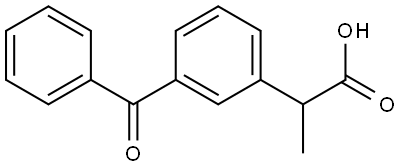
Ketoprofen
- Product NameKetoprofen
- CAS22071-15-4
- CBNumberCB3299418
- MFC16H14O3
- MW254.28
- EINECS244-759-8
- MDL NumberMFCD00055790
- MOL File22071-15-4.mol
- MSDS FileSDS
Chemical Properties
| Melting point | 93-96°C |
| Boiling point | 357.5°C (rough estimate) |
| Density | 1.1565 (rough estimate) |
| refractive index | 1.5600 (estimate) |
| storage temp. | 2-8°C |
| solubility | Slightly soluble in chloroform and methanol. |
| pka | pKa 5.94(MeOH/H2O) (Uncertain) |
| form | solid |
| color | White to Off-White |
| biological source | synthetic |
| Water Solubility | 209mg/L(room temperature) |
| Merck | 14,5305 |
| InChIKey | DKYWVDODHFEZIM-UHFFFAOYSA-N |
| CAS DataBase Reference | 22071-15-4(CAS DataBase Reference) |
| EWG's Food Scores | 1 |
| NCI Dictionary of Cancer Terms | ketoprofen |
| FDA UNII | 90Y4QC304K |
| NCI Drug Dictionary | ketoprofen |
Safety
| Symbol(GHS) |

|
|||||||||
| Signal word | Danger | |||||||||
| Hazard statements | H301 | |||||||||
| Precautionary statements | P264-P270-P301+P310-P405-P501 | |||||||||
| Hazard Codes | T | |||||||||
| Risk Statements | 25-36/37/38-23/24/25 | |||||||||
| Safety Statements | 26-45-36/37/39 | |||||||||
| RIDADR | 2811 | |||||||||
| WGK Germany | 3 | |||||||||
| RTECS | UE7570000 | |||||||||
| TSCA | Yes | |||||||||
| HazardClass | 6.1(b) | |||||||||
| PackingGroup | III | |||||||||
| HS Code | 29183000 | |||||||||
| Toxicity | LD50 orally in rats: 101 mg/kg (Ueno) | |||||||||
| NFPA 704: |
|




